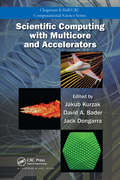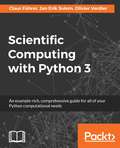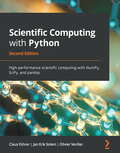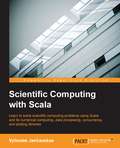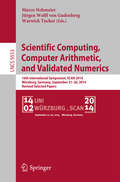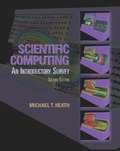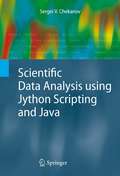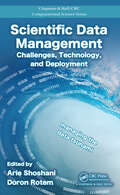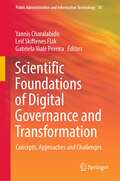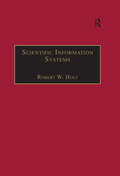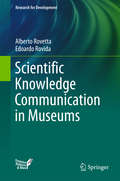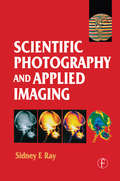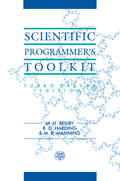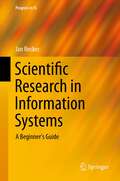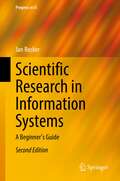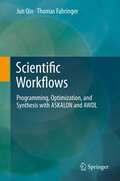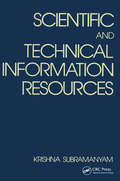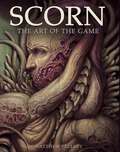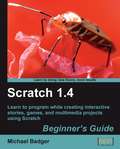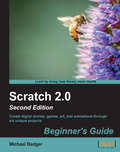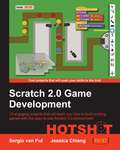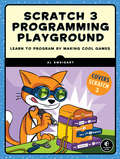- Table View
- List View
Scientific Computing with Multicore and Accelerators (Chapman & Hall/CRC Computational Science)
by Jack Dongarra David A. Bader Jakub KurzakThe hybrid/heterogeneous nature of future microprocessors and large high-performance computing systems will result in a reliance on two major types of components: multicore/manycore central processing units and special purpose hardware/massively parallel accelerators. While these technologies have numerous benefits, they also pose substantial perfo
Scientific Computing with Python 3
by Jan Erik Solem Claus Fuhrer Olivier VerdierAn example-rich, comprehensive guide for all of your Python computational needs About This Book • Your ultimate resource for getting up and running with Python numerical computations • Explore numerical computing and mathematical libraries using Python 3.x code with SciPy and NumPy modules • A hands-on guide to implementing mathematics with Python, with complete coverage of all the key concepts Who This Book Is For This book is for anyone who wants to perform numerical and mathematical computations in Python. It is especially useful for developers, students, and anyone who wants to use Python for computation. Readers are expected to possess basic a knowledge of scientific computing and mathematics, but no prior experience with Python is needed. What You Will Learn • The principal syntactical elements of Python • The most important and basic types in Python • The essential building blocks of computational mathematics, linear algebra, and related Python objects • Plot in Python using matplotlib to create high quality figures and graphics to draw and visualize your results • Define and use functions and learn to treat them as objects • How and when to correctly apply object-oriented programming for scientific computing in Python • Handle exceptions, which are an important part of writing reliable and usable code • Two aspects of testing for scientific programming: Manual and Automatic In Detail Python can be used for more than just general-purpose programming. It is a free, open source language and environment that has tremendous potential for use within the domain of scientific computing. This book presents Python in tight connection with mathematical applications and demonstrates how to use various concepts in Python for computing purposes, including examples with the latest version of Python 3. Python is an effective tool to use when coupling scientific computing and mathematics and this book will teach you how to use it for linear algebra, arrays, plotting, iterating, functions, polynomials, and much more. Style and approach This book takes a concept-based approach to the language rather than a systematic introduction. It is a complete Python tutorial and introduces computing principles, using practical examples to and showing you how to correctly implement them in Python. You'll learn to focus on high-level design as well as the intricate details of Python syntax. Rather than providing canned problems to be solved, the exercises have been designed to inspire you to think about your own code and give you real-world insight.
Scientific Computing with Python: High-performance scientific computing with NumPy, SciPy, and pandas, 2nd Edition
by Jan Erik Solem Claus Fuhrer Olivier VerdierLeverage this example-packed, comprehensive guide for all your Python computational needsKey FeaturesLearn the first steps within Python to highly specialized conceptsExplore examples and code snippets taken from typical programming situations within scientific computing.Delve into essential computer science concepts like iterating, object-oriented programming, testing, and MPI presented in strong connection to applications within scientific computing.Book DescriptionPython has tremendous potential within the scientific computing domain. This updated edition of Scientific Computing with Python features new chapters on graphical user interfaces, efficient data processing, and parallel computing to help you perform mathematical and scientific computing efficiently using Python. This book will help you to explore new Python syntax features and create different models using scientific computing principles. The book presents Python alongside mathematical applications and demonstrates how to apply Python concepts in computing with the help of examples involving Python 3.8. You'll use pandas for basic data analysis to understand the modern needs of scientific computing, and cover data module improvements and built-in features. You'll also explore numerical computation modules such as NumPy and SciPy, which enable fast access to highly efficient numerical algorithms. By learning to use the plotting module Matplotlib, you will be able to represent your computational results in talks and publications. A special chapter is devoted to SymPy, a tool for bridging symbolic and numerical computations. By the end of this Python book, you'll have gained a solid understanding of task automation and how to implement and test mathematical algorithms within the realm of scientific computing.What you will learnUnderstand the building blocks of computational mathematics, linear algebra, and related Python objectsUse Matplotlib to create high-quality figures and graphics to draw and visualize resultsApply object-oriented programming (OOP) to scientific computing in PythonDiscover how to use pandas to enter the world of data processingHandle exceptions for writing reliable and usable codeCover manual and automatic aspects of testing for scientific programmingGet to grips with parallel computing to increase computation speedWho this book is forThis book is for students with a mathematical background, university teachers designing modern courses in programming, data scientists, researchers, developers, and anyone who wants to perform scientific computation in Python.
Scientific Computing with Scala
by Vytautas JancauskasLearn to solve scientific computing problems using Scala and its numerical computing, data processing, concurrency, and plotting libraries About This Book * Parallelize your numerical computing code using convenient and safe techniques. * Accomplish common high-performance, scientific computing goals in Scala. * Learn about data visualization and how to create high-quality scientific plots in Scala Who This Book Is For Scientists and engineers who would like to use Scala for their scientific and numerical computing needs. A basic familiarity with undergraduate level mathematics and statistics is expected but not strictly required. A basic knowledge of Scala is required as well as the ability to write simple Scala programs. However, complicated programming concepts are not used in the book. Anyone who wants to explore using Scala for writing scientific or engineering software will benefit from the book. What You Will Learn * Write and read a variety of popular file formats used to store scientific data * Use Breeze for linear algebra, optimization, and digital signal processing * Gain insight into Saddle for data analysis * Use ScalaLab for interactive computing * Quickly and conveniently write safe parallel applications using Scala's parallel collections * Implement and deploy concurrent programs using the Akka framework * Use the Wisp plotting library to produce scientific plots * Visualize multivariate data using various visualization techniques In Detail Scala is a statically typed, Java Virtual Machine (JVM)-based language with strong support for functional programming. There exist libraries for Scala that cover a range of common scientific computing tasks - from linear algebra and numerical algorithms to convenient and safe parallelization to powerful plotting facilities. Learning to use these to perform common scientific tasks will allow you to write programs that are both fast and easy to write and maintain. We will start by discussing the advantages of using Scala over other scientific computing platforms. You will discover Scala packages that provide the functionality you have come to expect when writing scientific software. We will explore using Scala's Breeze library for linear algebra, optimization, and signal processing. We will then proceed to the Saddle library for data analysis. If you have experience in R or with Python's popular pandas library you will learn how to translate those skills to Saddle. If you are new to data analysis, you will learn basic concepts of Saddle as well. Well will explore the numerical computing environment called ScalaLab. It comes bundled with a lot of scientific software readily available. We will use it for interactive computing, data analysis, and visualization. In the following chapters, we will explore using Scala's powerful parallel collections for safe and convenient parallel programming. Topics such as the Akka concurrency framework will be covered. Finally, you will learn about multivariate data visualization and how to produce professional-looking plots in Scala easily. After reading the book, you should have more than enough information on how to start using Scala as your scientific computing platform Style and approach Examples are provided on how to use Scala to do basic numerical and scientific computing tasks. All the concepts are illustrated with more involved examples in each chapter. The goal of the book is to allow you to translate existing experience in scientific computing to Scala.
Scientific Computing, Computer Arithmetic, and Validated Numerics
by Warwick Tucker Marco Nehmeier Jürgen Wolff von GudenbergThis book constitutes the refereed post proceedings of the16th International Symposium, SCAN 2014, held in Würzburg, Germany, in September 2014. The 22 full papers presented were carefullyreviewed and selected from 60 submissions. The main concerns of research addressed by SCAN conferences are validation, verification or reliable assertions of numerical computations. Interval arithmetic and other treatments of uncertainty are developed as appropriate tools.
Scientific Computing, Computer Arithmetic, and Validated Numerics: 16th International Symposium, SCAN 2014, Würzburg, Germany, September 21-26, 2014. Revised Selected Papers (Lecture Notes in Computer Science #9553)
by Warwick Tucker Marco Nehmeier Jürgen Wolff von GudenbergThis book constitutes the refereed post proceedings of the 16th International Symposium, SCAN 2014, held in Würzburg, Germany, in September 2014. The 22 full papers presented were carefully reviewed and selected from 60 submissions. The main concerns of research addressed by SCAN conferences are validation, verification or reliable assertions of numerical computations. Interval arithmetic and other treatments of uncertainty are developed as appropriate tools.
Scientific Computing: A Historical Perspective (Texts in Computational Science and Engineering #8)
by Bertil GustafssonThis book explores the most significant computational methods and the history of their development. It begins with the earliest mathematical / numerical achievements made by the Babylonians and the Greeks, followed by the period beginning in the 16th century. For several centuries the main scientific challenge concerned the mechanics of planetary dynamics, and the book describes the basic numerical methods of that time. In turn, at the end of the Second World War scientific computing took a giant step forward with the advent of electronic computers, which greatly accelerated the development of numerical methods. As a result, scientific computing became established as a third scientific method in addition to the two traditional branches: theory and experimentation. The book traces numerical methods’ journey back to their origins and to the people who invented them, while also briefly examining the development of electronic computers over the years. Featuring 163 references and more than 100 figures, many of them portraits or photos of key historical figures, the book provides a unique historical perspective on the general field of scientific computing – making it a valuable resource for all students and professionals interested in the history of numerical analysis and computing, and for a broader readership alike.
Scientific Computing: An Introductory Survey
by Michael T. HeathThis book presents a broad overview of numerical methods for solving all the major problems in scientific computing.
Scientific Data Analysis using Jython Scripting and Java
by Sergei V. ChekanovScientific Data Analysis using Jython Scripting and Java presents practical approaches for data analysis using Java scripting based on Jython, a Java implementation of the Python language. The chapters essentially cover all aspects of data analysis, from arrays and histograms to clustering analysis, curve fitting, metadata and neural networks. A comprehensive coverage of data visualisation tools implemented in Java is also included. Written by the primary developer of the jHepWork data-analysis framework, the book provides a reliable and complete reference source laying the foundation for data-analysis applications using Java scripting. More than 250 code snippets (of around 10-20 lines each) written in Jython and Java, plus several real-life examples help the reader develop a genuine feeling for data analysis techniques and their programming implementation. This is the first data-analysis and data-mining book which is completely based on the Jython language, and opens doors to scripting using a fully multi-platform and multi-threaded approach. Graduate students and researchers will benefit from the information presented in this book.
Scientific Data Management: Challenges, Technology, and Deployment
by Arie Shoshani Doron RotemDealing with the volume, complexity, and diversity of data currently being generated by scientific experiments and simulations often causes scientists to waste productive time. Scientific Data Management: Challenges, Technology, and Deployment describes cutting-edge technologies and solutions for managing and analyzing vast amounts of data, helping
Scientific Discovery in the Social Sciences (Synthese Library #413)
by Fernand Gobet Mark Addis Peter C. R. Lane Peter D. SozouThis volume offers selected papers exploring issues arising from scientific discovery in the social sciences. It features a range of disciplines including behavioural sciences, computer science, finance, and statistics with an emphasis on philosophy.The first of the three parts examines methods of social scientific discovery. Chapters investigate the nature of causal analysis, philosophical issues around scale development in behavioural science research, imagination in social scientific practice, and relationships between paradigms of inquiry and scientific fraud. The next part considers the practice of social science discovery. Chapters discuss the lack of genuine scientific discovery in finance where hypotheses concern the cheapness of securities, the logic of scientific discovery in macroeconomics, and the nature of that what discovery with the Solidarity movement as a case study. The final part covers formalising theories in social science. Chapters analyse the abstract model theory of institutions as a way of representing the structure of scientific theories, the semi-automatic generation of cognitive science theories, and computational process models in the social sciences.The volume offers a unique perspective on scientific discovery in the social sciences. It will engage scholars and students with a multidisciplinary interest in the philosophy of science and social science.
Scientific Foundations of Digital Governance and Transformation: Concepts, Approaches and Challenges (Public Administration and Information Technology #38)
by Yannis Charalabidis Gabriela Viale Pereira Leif Skiftenes FlakThis book provides the latest research advancements and findings for the scientific systematization of knowledge regarding digital governance and transformation, such as core concepts, foundational principles, theories, methodologies, architectures, assessment frameworks and future directions. It brings forward the ingredients of this new domain, proposing its needed formal and systematic tools, exploring its relation with neighbouring scientific domains and finally prescribing the next steps for laying the foundations of a new science. The book is structured into three main areas. The first section focuses on contributions towards the purpose, ingredients and structure of the scientific foundations of digital transformation in the public sector. The second looks at the identification and description of domain's scientific problems with a view to stabilizing research products, assessment methods and tools in a reusable, extendable and sustainable manner. The third envisions a pathway for future research to tackle broader governance problems via the applications of information and communication technologies in combination with innovative approaches from neighbouring scientific domains. Contributing to the analysis of the scientific perspectives of digital governance and digital transformation, this book will be an indispensable tool for students, researchers and practitioners interested in digital governance, digital transformation, information systems, as well as ICT industry experts and policymakers charged with the design, deployment and implementation of public sector information systems.
Scientific Information Systems
by Robert W. HoltSafety critical jobs in fields such as aviation and nuclear power plants require a careful and comprehensive analysis of all factors relevant to critical job performance. Understanding how these factors uniquely and in combination, affect performance requires interconnecting a job performance database with several other information databases. The scientific method is necessary to ensure information quality; to solve problems or project trends; and to correctly evaluate changes in selection, training, performance evaluation, the person-machine interface, or team dynamics. Combining the scientific method with the construction, validation and use of the information databases results in a Scientific Information System (SIS), which joins practical utility with powerful evauations of relevant theories. This book discusses how to blend scientific methods with the broad capabilities of computer database information systems. This synthesis will aid anyone who is trying to explain, predict, or change the behavior of a complex system involving humans. Whilst developed from research on information systems in the aviation industry, the principles and methods are universal and the book provides conceptual guidance for the construction and use of such systems in other domains. The examples clarify the advantages of this type of information system and the enormous potential power for understanding a target system completely and accurately.
Scientific Knowledge Communication in Museums (Research For Development Ser.)
by Edoardo Rovida Alberto RovettaThis book explains the general principles of scientific and technical communication in the context of modern museums. It also examines, with the aid of informative case studies, the different means by which knowledge can be transmitted, including posters, objects, explanatory guidance, documentation, and catalogues. Highlighting the ever more important role of multimedia and virtual reality components in communicating understanding of and facilitating interaction with the displayed object, it explores how network communications systems and algorithms can be applied to offer individual users the information that is most pertinent to them. The book is supported by a Dynamic Museums app connected to museum databases where series of objects can be viewed via cloud computing and the Internet and printed using 3D printing technology. This book is of interest to a diverse readership, including all those who are responsible for museums’ collections, operations, and communications as well as those delivering or participating in courses on museums and their use, communication design and related topics.
Scientific Photography and Applied Imaging
by Sidney RayWINNER OF THE 2001 KRASZNA-KRAUSZ PHOTOGRAPHY BOOK AWARD (Technical Photography category)The only definitive book to fully encompass the use of photography and imaging as tools in science, technology and medicine. It describes in one single volume the basic theory, techniques, materials, special equipment and applications for a wide variety of uses of photography, including: close up photography and photomacrography to spectral recording, surveillance systems, radiography and micro-imaging. This extensively illustrated photography 'bible' contains all the information you need, whether you are a scientist wishing to use photography for a specialist application, a professional needing to extend technical expertise, or a student wanting to broaden your knowledge of the applications of photography.The contents are arranged in three sections:· General Section, detailing the elements of the image capture process· Major Applications, describing the major applications of imaging · Specialist Applications, presenting an eclectic selection of more specialised but increasingly important applicationsEach subject is introduced with an outline of its development and contemporary importance, followed by explanations of essential theory and an overview of techniques and equipment. Mathematics is only used where necessary. Numerous applications and case studies are described. Comprehensive bibliographies and references are provided for further study.
Scientific Programmer's Toolkit: Turbo Pascal Edition
by M.H BeilbyThe Scientific Programmer's Toolkit: Turbo Pascal Edition presents a complete software environment for anyone writing programs in mathematical, engineering, or science areas. This toolkit package is designed for use with Turbo Pascal, the de facto standard Pascal system for PC and compatible machines. The book and its software provides an integrated software library of programming tools. The programs and routines fall into three categories: graphical, mathematical, and utilities. Routines are further subdivided into three levels that reflect the experience of the user. For graphics and text handling routines there is also a Level 0, which provides an interface to the machine operating system. By using hierarchically structured routines, the clearly written text, and a wide range of example programs, software users can construct a user-friendly interface with minimal effort. The levels structure makes it easy for newcomers to use the Toolkit, and with growing experience, users can achieve more elaborate effects.The Scientific Programmer's Toolkit will be useful to consultants, researchers, and students in any quantitative profession or science, in private or public sector research establishments, or in secondary and higher education.
Scientific Research in Information Systems
by Jan ReckerThis book is designed to introduce doctoral and other higher-degree research students to the process of scientific research in the fields of Information Systems as well as fields of Information Technology, Business Process Management and other related disciplines within the social sciences. It guides research students in their process of learning the life of a researcher. In doing so, it provides an understanding of the essential elements, concepts and challenges of the journey into research studies. It also provides a gateway for the student to inquire deeper about each element covered . Comprehensive and broad but also succinct and compact, the book is focusing on the key principles and challenges for a novice doctoral student.
Scientific Research in Information Systems: A Beginner's Guide (Progress in IS)
by Jan ReckerThis book introduces higher-degree research students and early career academics to scientific research as occurring in the field of information systems and adjacent fields, such as computer science, management science, organization science, and software engineering. Instead of focusing primarily on research methods as many other textbooks do, it covers the entire research process, from start to finish, placing particular emphasis on understanding the cognitive and behavioural aspects of research, such as motivation, modes of inquiry, theorising, planning for research, planning for publication, and ethical challenges in research. Comprehensive but also succinct and compact, the book guides beginning researchers in their quest to do scholarly work and to assist them in developing their own answers and strategies over the course of their work. Jan Recker explains in this book the fundamental concepts that govern scientific research and then moves on to introduce the basic steps every researcher undertakes: choosing research questions, developing theory, building a research design, employing research methods, and finally writing academic papers. He also covers essentials of ethical conduct of scientific research. This second edition contains major updates on all these elements plus significant expansions on relevant research methods such as design research and computational methods, a rewritten and extended chapter on theory development, and expansions to the chapters on research methods, scientific publishing, and research ethics. A companion website provides pedagogical materials and instructions for using this book in teaching.
Scientific Workflows
by Jun Qin Thomas FahringerCreating scientific workflow applications is a very challenging task due to the complexity of the distributed computing environments involved, the complex control and data flow requirements of scientific applications, and the lack of high-level languages and tools support. Particularly, sophisticated expertise in distributed computing is commonly required to determine the software entities to perform computations of workflow tasks, the computers on which workflow tasks are to be executed, the actual execution order of workflow tasks, and the data transfer between them. Qin and Fahringer present a novel workflow language called Abstract Workflow Description Language (AWDL) and the corresponding standards-based, knowledge-enabled tool support, which simplifies the development of scientific workflow applications. AWDL is an XML-based language for describing scientific workflow applications at a high level of abstraction. It is designed in a way that allows users to concentrate on specifying such workflow applications without dealing with either the complexity of distributed computing environments or any specific implementation technology. This research monograph is organized into five parts: overview, programming, optimization, synthesis, and conclusion, and is complemented by an appendix and an extensive reference list. The topics covered in this book will be of interest to both computer science researchers (e.g. in distributed programming, grid computing, or large-scale scientific applications) and domain scientists who need to apply workflow technologies in their work, as well as engineers who want to develop distributed and high-throughput workflow applications, languages and tools.
Scientific and Technical Information Resources
by Krishina SubramanyamThis book focuses on current practices in scientific and technical communication, historical aspects, and characteristics and bibliographic control of various forms of scientific and technical literature. It integrates the inventory approach for scientific and technical communication.
Scorn: The Art of the Game
by Matthew PellettOfficial lavish in-depth coffee table art book for the first-person horror adventure game Scorn, inspired by H.R. Giger and Zdzisław Beksiński, to be released on Xbox series X/S, Microsoft Windows, Steam, and Windows Store.In this coffee table hardback, uncover the concept and vision behind Scorn, alongside insight from the artists and software designers at Ebb. The game is set in a nightmarish universe of odd forms and somber tapestry inspired by the work of H.R. Giger, and designed around the idea of "being thrown into the world". This lavish book explores the characters, creatures, weapons, and locations, with maps, user interfaces, concept art, and original designs. The unsettling biomechanical environment is a character in itself, and every location reveals its own theme, puzzles, and characters that are integral in creating a cohesive lived-in world. &“It blends the anatomical and organic with the mechanical and architectural to create fleshy, irregular landscapes inhabited by shambling monstrosities&” – PC Gamer magazine
Scratch 1.4: Beginner’s Guide
by Michael BadgerThis is a Packt Beginners Guide, which means it focuses on practical examples and has a friendly approach, with the opportunity to learn by experiment and play. We work through the project tutorials one block of code at a time, and we periodically pause to reflect on the relationship between our code blocks, our project, and Scratch programming in general. As you work through the book, you are encouraged to experiment with the concepts presented. As each chapter in the book progresses, the topics get increasingly more complex.Scratch is a teaching language, so it's ideal for people who want to learn how to program or teach others how to program. Educators and parents will learn how to program using Scratch, so they can use Scratch to teach the latest learning skills to their students and children.No previous computer programming knowledge is required. You only need to know how to perform basic tasks on a computer and this book will teach the rest. You can then use it as a platform to learn more advanced programming languages.Parents, stuck with a child who wants to play video games all night? Make a new rule. He can only play a video game if he programs the game first.
Scratch 2.0 Beginner's Guide Second Edition
by Michael BadgerThe book uses step-by-step instructions along with full code listings for each exercise. After each exercise, the author pauses to reflect, explain, and offer insights before building on the project. The author approaches the content with the belief that we are all teachers and that you are reading this book not only because you want to learn, but because you want to share your knowledge with others. Motivated students can pick up this book and teach themselves how to program because the book takes a simple, strategic, and structured approach to learning Scratch. Parents can grasp the fundamentals so that they can guide their children through introductory Scratch programming exercises. It's perfect for homeschool families. Teachers of all disciplines from computer science to English can quickly get up to speed with Scratch and adapt the projects for use in the classroom.
Scratch 2.0 Game Development HOTSHOT
by Sergio Van Pul Jessica ChiangAn easy-to-use book, containing 10 engaging projects that will help you learn how to build video games with the easy to use Scratch 2.0 environment. If you are a new, or current Scratch user and would like to improve your understanding of the new Scratch 2.0 interface, and learn how to make video games, this book is ideal for you. Each project is explained in-depth from start to finish, so everyone can follow along, even if you don't have much previous experience with the software. If you want to become a video game designer, this book is an easy- to- use and friendly guide about the world of interactive media. It will teach, challenge, and inspire you to create great interactive projects.
Scratch 3 Programming Playground: Learn to Program by Making Cool Games
by Al SweigartA project-filled introduction to coding that shows kids how to build programs by making cool games. Scratch, the colorful drag-and-drop programming language, is used by millions of first-time learners worldwide. Scratch 3 features an updated interface, new programming blocks, and the ability to run on tablets and smartphones, so you can learn how to code on the go.In Scratch 3 Programming Playground, you'll learn to code by making cool games. Get ready to destroy asteroids, shoot hoops, and slice and dice fruit! Each game includes easy-to-follow instructions with full-color images, review questions, and creative coding challenges to make the game your own. Want to add more levels or a cheat code? No problem, just write some code.You'll learn to make games like: • Maze Runner: escape the maze! • Snaaaaaake: gobble apples and avoid your own tail • Asteroid Breaker: smash space rocks • Fruit Slicer: a Fruit Ninja clone • Brick Breaker: a remake of Breakout, the brick-breaking classic • Platformer: a game inspired by Super Mario BrosLearning how to program shouldn't be dry and dreary. With Scratch 3 Programming Playground, you'll make a game of it!Covers: Scratch 3
